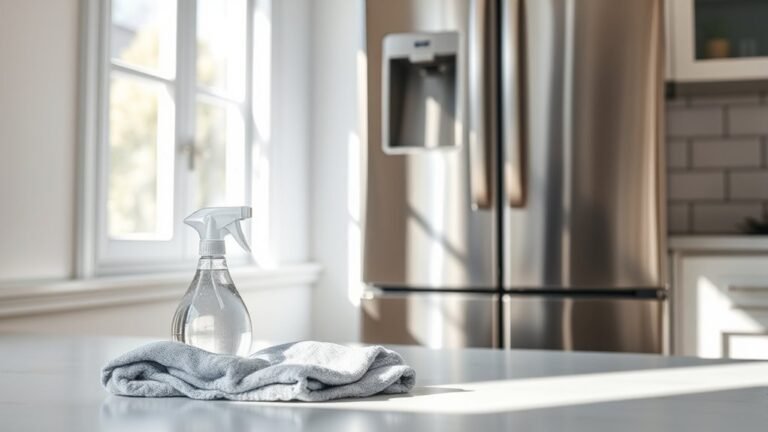How to Clean Your AC Safely
To clean your AC safely, first turn off the power at the breaker to avoid electrical hazards. Gather essential tools like gloves, a soft brush, vacuum, and an appropriate cleaner. Remove and clean or replace filters before gently cleaning coils with a coil cleaner and rinsing if needed. Clear debris from the outdoor unit, clean the drain line, and inspect fan blades for damage. After reassembling, test your unit to verify proper function. Following these steps will help you understand how to keep your AC running smoothly and efficiently.
Assessing Your Air Conditioner Type

Before you start cleaning, it’s important to identify what type of air conditioner you have. Knowing whether you’re dealing with window units, central systems, portable conditioners, or split systems helps you approach cleaning confidently and efficiently. Each type has its quirks—window units are compact and easy to access, while central systems involve ductwork and filters spread throughout your home. Portable conditioners offer flexibility but require regular filter checks, and split systems have separate indoor and outdoor units that need different care. By pinpointing your AC type, you gain the freedom to clean it safely without unnecessary guesswork. This guarantees your efforts are effective, keeping your air fresh and your unit running smoothly, all while protecting your comfort zone.
Gathering Essential Cleaning Supplies
Before you start cleaning, make sure you have the right tools like a soft brush and a vacuum. Picking a cleaner that’s safe for your AC’s materials is key to avoid damage. Don’t forget to wear gloves and eye protection to keep yourself safe throughout the process.
Must-Have Cleaning Tools
You’ll need a few essential tools to clean your AC effectively and safely. Start with basic cleaning gadgets like a soft brush and a microfiber cloth to gently remove dust without damaging delicate parts. A vacuum with a brush attachment is a must for clearing debris from vents and coils. Don’t forget maintenance tools such as a fin comb to straighten bent fins and a screwdriver for opening panels. Gloves will protect your hands, and a spray bottle filled with water helps rinse surfaces without excess moisture. Having these tools ready empowers you to take control of your AC upkeep, ensuring freedom from costly repairs and prolonged comfort in your space. With the right cleaning gadgets and maintenance tools, you’re set to keep your AC running smoothly.
Choosing the Right Cleaner
Selecting the right cleaner is essential for maintaining your AC’s efficiency without causing damage. You want a product that’s effective yet gentle, allowing you the freedom to clean without worry. Eco friendly cleaners offer a safe, biodegradable choice that protects both your unit and the environment. Alternatively, commercial cleaners provide powerful solutions but require careful use to avoid harm. Here’s a quick guide to help you pick:
| Cleaner Type | Benefits |
|---|---|
| Eco Friendly Cleaners | Non-toxic, biodegradable |
| Commercial Cleaners | Strong, fast-acting |
| Foaming Coil Cleaners | Deep clean for coils |
| All-Purpose Cleaners | Versatile, easy to use |
Choose based on your comfort level and the AC’s needs to keep your cooling system running smoothly and safely.
Safety Gear Essentials
After choosing the right cleaner for your AC, it’s important to gear up properly to protect yourself during the cleaning process. First, prioritize gloves usage to shield your hands from harsh chemicals and grime. Durable, chemical-resistant gloves let you work confidently without worrying about skin irritation. Next, don’t skip eye protection—safety goggles or glasses prevent splashes from reaching your eyes, keeping you safe from potential harm. Wearing the right safety gear isn’t about restriction; it’s about giving you the freedom to clean your AC effectively and confidently. By preparing with essential protective equipment, you guarantee a smooth, safe experience that empowers you to maintain your system without risk. Stay safe and enjoy the independence that comes with doing it yourself.
Turning Off Power to the Unit
Before you begin cleaning, make sure to turn off the power to your AC unit to prevent any accidents. This step is essential for your safety and protects the unit from damage. You’ll want to cut off the power source completely before touching any components.
Here’s how to handle it effectively:
- Locate the main circuit breaker or the dedicated AC switch.
- Flip the breaker to the “off” position or switch off the AC power.
- Confirm no power is running by testing the unit briefly.
- Keep the breaker off until all cleaning is finished.
- Avoid working around the unit if you’re unsure about electrical safety precautions.
Taking control of the power gives you the freedom to clean confidently and safely.
Removing and Cleaning the Air Filters

Once the power is safely off, you can focus on removing the air filters. Depending on your AC model, filters might slide out or require unclipping. Knowing your air filter types—like fiberglass, pleated, or electrostatic—helps you decide the best cleaning approach. For reusable filters, gently vacuum or wash with mild soap and water, then let them dry completely before reinstalling. Disposable filters should be replaced regularly to maintain airflow and efficiency. Remember these filter maintenance tips: clean or replace filters every 1-3 months, especially during heavy use, to keep your AC running freely. Taking charge of your filter care not only boosts performance but also grants you the freedom to enjoy crisp, clean air without relying on costly professional services.
Cleaning the Evaporator and Condenser Coils
Now that you’ve cleaned the air filters, it’s time to tackle the evaporator and condenser coils. You’ll need the right tools and a suitable cleaning solution to get the job done effectively. Follow a simple step-by-step process to guarantee your coils are free of dirt and debris.
Coil Cleaning Tools
Cleaning the evaporator and condenser coils requires the right tools to get the job done effectively and safely. Knowing the best coil cleaning techniques and maintaining a proper coil cleaning frequency will keep your AC running freely and efficiently. Here’s what you’ll need to tackle the task:
- Soft-bristle brush for loosening debris without damaging fins
- Coil fin comb to straighten bent fins and improve airflow
- Garden hose with a gentle spray nozzle for rinsing coils
- Protective gloves to keep your hands safe from sharp edges and dirt
- Vacuum with a brush attachment for initial dust removal
With these tools, you can confidently maintain your coils, ensuring your AC stays in peak condition and you enjoy the freedom of a cool, clean home.
Cleaning Solution Options
Choosing the right cleaning solution is key to effectively removing dirt and grime from your AC coils without causing damage. You want something powerful yet gentle, so eco friendly cleaners are an excellent choice. They clean thoroughly while protecting the environment and your health. If you prefer total control, homemade solutions using simple ingredients like vinegar and water can do the trick. These DIY mixes break down buildup and are safe to use on both evaporator and condenser coils. Avoid harsh chemicals that might corrode delicate fins or leave harmful residues. By selecting the right cleaning solution, you maintain your AC’s efficiency and extend its lifespan—all while staying true to a lifestyle that values freedom and responsibility.
Step-by-Step Cleaning Process
Before you start, make certain your AC unit is turned off and unplugged to guarantee safety. Cleaning the evaporator and condenser coils is key for preventive maintenance and seasonal checks. First, remove the outer panels carefully. Then, use a soft brush or vacuum to clear dust and debris. Next, apply a no-rinse coil cleaner or a mild cleaning solution. Allow it to sit for 10-15 minutes to break down grime. Finally, rinse gently with water if needed and let everything dry before reassembling.
Remember these essentials:
- Always disconnect power
- Handle coils gently
- Use appropriate cleaning solutions
- Perform seasonal checks regularly
- Keep work area well-ventilated
Following this step-by-step process frees you from costly repairs and keeps your AC running smoothly.
Clearing Debris From the Outdoor Unit
When you’re maintaining your AC, clearing debris from the outdoor unit is essential to keep it running efficiently. Debris removal not only boosts performance but also extends your freedom from costly repairs. Outdoor maintenance is your chance to reclaim control and guarantee fresh airflow. Grab gloves and a soft brush, then gently clear leaves, dirt, and twigs without damaging fins.
| Feeling | Result |
|---|---|
| Relief | Unit runs smoothly |
| Confidence | You control your comfort |
| Freedom | Avoid unexpected breakdowns |
| Satisfaction | Clean, efficient system |
| Empowerment | DIY outdoor maintenance |
Keeping your unit debris-free is a simple act that protects your independence and peace of mind all summer long.
Checking and Cleaning the Drain Line

Two simple tools—a wet/dry vacuum and a stiff brush—can help you keep your AC’s drain line clear and functioning properly. Regular drain line maintenance is essential for clogged drain prevention, ensuring your system runs smoothly without water backups or damage. Here’s how you can take control:
- Locate the drain line access point near the indoor unit.
- Use the vacuum to suck out any debris or buildup inside the drain pipe.
- Gently scrub around the access area with the stiff brush to remove mold or mildew.
- Flush the line with a cup of white vinegar to kill bacteria and maintain flow.
- Repeat this process every few months to avoid blockages and keep your AC carefree.
Inspecting the Fan and Blades
Maintaining a clear drain line helps prevent water damage, but it’s just as important to keep your AC’s fan and blades in good shape. Fan maintenance plays a vital role in ensuring your unit runs efficiently and quietly. Start by turning off the power and removing the fan cover. Carefully check each blade for dirt buildup, cracks, or warping during your blade inspection. Dirty or damaged blades can cause imbalance, leading to noise and reduced airflow. Use a soft brush or cloth to gently clean the blades, avoiding bending them. If you spot any damage, replace the blade to keep your system running smoothly. Regular fan maintenance not only extends your AC’s lifespan but also gives you the freedom to enjoy cool air without unexpected breakdowns.
Reassembling and Testing the AC Unit
After you’ve thoroughly cleaned and inspected all parts, you’ll want to carefully reassemble your AC unit to confirm everything fits securely and functions properly. When reassembling unit components, take your time to avoid forcing pieces together, which can cause damage or misalignment. Once everything is back in place, testing functionality is vital to guarantee your AC runs smoothly and efficiently.
Here are key steps to keep in mind:
- Double-check all screws and fasteners for tightness
- Reconnect electrical components correctly
- Confirm fan blades spin freely without obstruction
- Verify filters are clean and properly seated
- Power on the unit and listen for unusual noises
Following these tips will help you regain full control over your cooling system and enjoy the freedom of a well-maintained AC.
Frequently Asked Questions
How Often Should I Schedule Professional AC Maintenance?
You should schedule professional AC maintenance at least once a year to keep things running smoothly. The ideal AC maintenance frequency often aligns with seasonal changes, so spring or early summer is perfect before heavy use. Following seasonal maintenance tips helps you avoid unexpected breakdowns and extends your unit’s life, giving you the freedom to enjoy cool comfort without hassle. Staying on top of this will save you time and stress later.
Can Using Vinegar Damage My AC Coils?
You might worry that using vinegar could damage your AC coils, but if you use it properly, vinegar benefits include effective cleaning without harsh chemicals. Just dilute vinegar with water to protect the coils and avoid corrosion. This simple approach gives you freedom to maintain your AC safely at home, keeping it efficient and extending its life. So, don’t shy away—vinegar can be a gentle, natural option for coil protection.
What Are the Signs My AC Needs Cleaning?
If you notice your AC isn’t cooling like before or your energy bills are spiking, those are clear signs neglect might be causing trouble. Dirty filters are a common culprit, restricting airflow and making your unit work harder than it should. You might also feel uneven cooling or hear strange noises. Don’t let a dirty AC hold you back—keeping it clean guarantees you stay comfortable and free from unnecessary stress.
Is It Safe to Clean the AC During Winter?
Imagine the chill outside while your AC sits idle—winter cleaning might seem odd, but it’s totally doable. You can safely clean your AC during winter, just take safety precautions like turning off power and wearing gloves to avoid frostbite. This off-season care frees you from last-minute hassles and keeps your unit ready for summer. Embrace winter cleaning as a smart step toward comfort and independence when warm days return.
How Can I Improve My Ac’S Energy Efficiency?
To boost your AC’s energy efficiency, start by adjusting your thermostat settings wisely—set it a few degrees higher when you’re not home to save energy without sacrificing comfort. Also, don’t forget to regularly replace or clean your air filter; a clogged filter makes your system work harder, wasting energy. These simple steps give you more control, helping you enjoy a cool space while freeing yourself from high energy bills.






